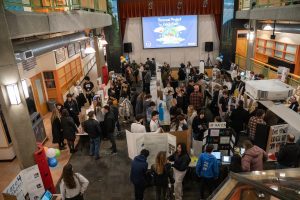
Personal Project
Personal Project NEWS
IB MYP Personal Project Exhibition
 Annually, our Grade 10 students have the opportunity to dream, set goals, work towards and create a passion project through the Personal Project in completion of their MYP certificate.
Annually, our Grade 10 students have the opportunity to dream, set goals, work towards and create a passion project through the Personal Project in completion of their MYP certificate.
We celebrate these learning journeys, hard work and achievements every year at the Personal Project Exhibition! Students put their projects on display for Rockridge staff, students, their parents and the wider community to explore.
It’s a wonderful celebration of inspiration, uniqueness and learning that we hope you are able to experience one day!
Information for families
Parents/Guardians of Rockridge students can learn more about the Personal Project to support their learners through the following sources:
- Introduction to Personal Project for Students
- Personal Project One-Page Overview
- Personal Project Student Handbook
Important Details about the Personal Project at Rockridge:
- Students complete their Personal Projects from September – March
- Student progress in Personal Project is supported through learning opportunities provided during the CLE10 course
- Successful completion of the personal project is a requirement for Honour Roll and MYP Certificate eligibility
- Personal Project 10 is a two-credit course that appears on all student transcripts
- The Personal Project acts as evidence for the Grade 12 Capstone project (a Graduation Requirement)
Personal Project Course Description
MYP students in their final year (Grade 10) explore an area of personal interest over an extended period through the IB MYP Personal Project. The project provides students with the opportunity to consolidate their learning, explore personal interests, and build capacity for next steps in their education, life, and work.
The Personal Project is a 2-credit independent directed study that is required to complete the MYP Certificate. The course is facilitated through the Career Life Education 10 (CLE10) course and involves self-directed inquiry, action, and reflection to demonstrate skills that support their lifelong learning. Over the course of the year, students identify a learning goal and corresponding product goal, create their product, reflect on their learning journey, and share their experience with the school community during the annual MYP Exhibition.
Elements of the Personal Project
The personal project formally assesses students’ approaches to learning (ATL) skills for self-management, research, communication, thinking, and collaboration.
Students complete these elements:
- PRODUCT or OUTCOME — evidence of tangible or intangible results: what the student was aiming to achieve or create (examples below)**
- PROCESS JOURNAL —some form of recorded process/progress during the project (e.x. ideas, criteria, developments, challenges, plans, research, possible solutions, progress reports, reflections, etc.)
- REPORT —an account of the project and its impact in a structure that follows assessment criteria. The report includes a bibliography and curated evidence from the process journal that documents students’ development and achievements.
- EXHIBITION – in-person conversations with members of the school community during which students’ share their learning journey.
Assessment of student proficiency in this course is based on the Personal Project Report, which is largely informed by the product students create and evidence from their process journal.
Find more information about the IB MYP Personal Project on the IB Projects Page.
**Possible Product Formats (this list is non-exhaustive):
- Performance: play, dance, song, speech, comedy routine, podcast
- Written Work: creative prose, awareness campaign, instructional guide, collection of poetry, critique/review, health regime, piece of music, major essay, short story, children’s book, extended article, script, research project, fundraising campaign
- Planned/Hosted Event: Fund-raising evening, awareness drive, charity event, school event
- Physical Work: woodcarving, metalwork, sculpture, scale model, robotics, 3-D artifact
- Static Visual Display: photographs, art, poster, artifact, drawings,
- Digital Display: web site, video, audio recording, animation, video game